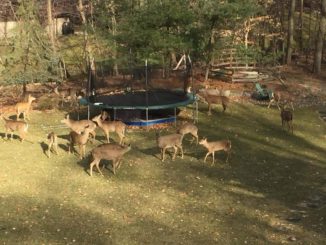
[slideshow_deploy id=’899′]
BY MICHAEL OLOHAN
OF NORTHERN VALLEY PRESS
ENGLEWOOD, NEW JERSEY —— Forty deer were spotted in an approximately 5-square-mile area of Englewood by volunteers of the city’s new Deer Task Force – almost double the amount spotted eight years ago – during a recent January evening survey.
“You were seeing over double the amount of deer in our city… spread across all the wards,” compared to a 2010 survey, said Councilman Michael Cohen at the Jan. 23 council meeting. “You saw quite a bit of deer and quite a bit of growth.”
Previously Cohen has mentioned deer appear to be more prevalent in Englewood and suggested such increase may be a cause of vehicle accidents, injuries, and spreading of diseases such as Lyme.
‘Dramatically different’
Cohen said the 40 deer were spotted during a Jan. 9 survey and the “dramatically different results” from a 2010 survey would be addressed by a newly formed Deer Task Force. He said the task force will set a timetable and make public safety recommendations to the council.
To get a snapshot of deer numbers, four city vehicles with four city drivers scoured the city on Jan. 9 between 5:45 p.m. and 8:30 p.m. Spotters counted the following numbers: Ward 1 – 11 females; Ward 2 – 10 females; Ward 3 – 13 females; and Ward 4 – four male and two female deer.
Two spotters
“There were a minimum of three people in each vehicle, one driver and two spotters. The vehicles were driven by city employees and two other people [volunteers or other city employees] were passengers, so spotting took place on both sides of the vehicle. The vehicles drove at a slow pace to ensure that deer could be easily spotted and not missed,” states the Winter 2018 Englewood Deer Population report.
However, while the numbers spotted were fairly even in wards across the city, what the survey numbers mean is not certain, said a task force member.
“Deer are throughout the community of Englewood,” said Stephen Wiessner, Flat Rock Brook’s executive director and a group member. “When they spotted the deer, they wrote down the roads where they were spotted,” he said. He said he was not sure what the “carrying capacity” of a city such as Englewood might be for deer.
The survey follows numerous complaints by residents – and concerns voiced by Cohen at several 2017 council meetings that deer are an increasing problem, both to drivers and residents.
Wiessner said the deer survey used the “spotlight method.” He said he expected the committee would keep gathering data and possibly reach out to other neighboring municipalities.
“This is a first step, a start to a conversation on what we might do,” Wiessner said.
He said Flat Rock Brook decided to construct a “deer exclosure fence” at its 150-acre preserve to keep deer out of the nature center. He said deer were feeding on the forest’s native tree seedlings and saplings, destroying habitat for wildlife and leading to the spread of non-native plants.
[slideshow_deploy id=’899′]
Next steps
Wiessner said while it might not be possible to deduce much from one survey, the task force was focused on next steps. Lisa Wisotsky, president of Friends of John T. Wright Ice Arena, is Deer Task Force chair.
Wisotsky said public safety issues, including traffic accidents, Lyme disease, and destruction of landscapes by deer are major complaints. She said the task’s force first meeting looked at a variety of government reports compiling deer statistics, including deer-vehicle motor accidents.
She said next steps include a process to move forward, public education and outreach – including a public presentation by a state agency on deer issues – and building partnerships for a regional deer-management approach.
Cohen thanked Wisotsky and Health Department Director James Fedorko for putting together a group to help Englewood address deer concerns.
“There’s not going to be an overnight solution to this and there’s not going to be an easy solution,” said Cohen, who often mentions deer overpopulation as a regional issue that requires a regional solution.



